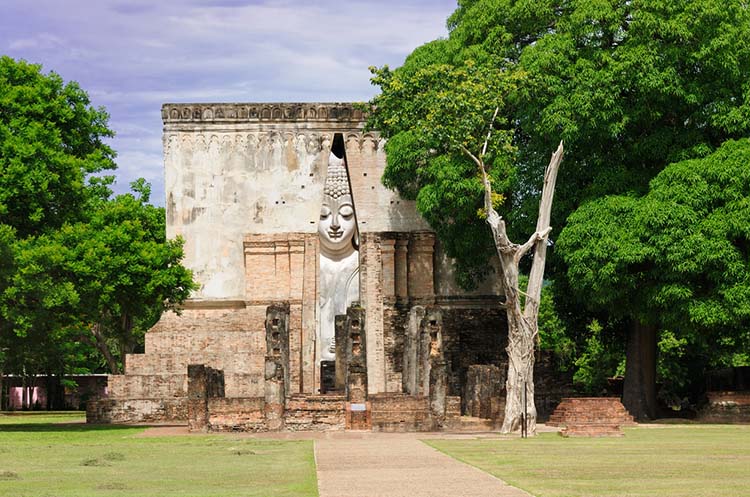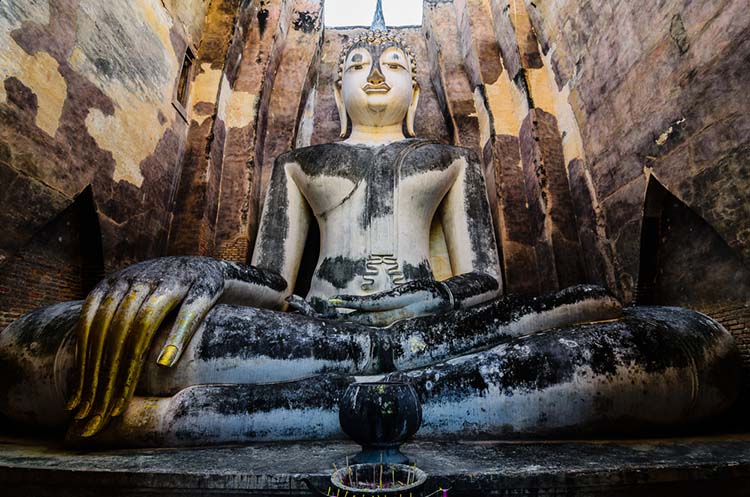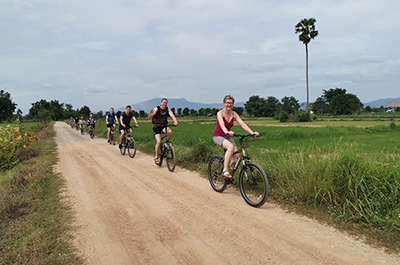
Wat Si Chum
Located in the North zone of the Sukhothai Historical Park outside the walled city is the Wat Si Chum temple, known for its mondop with a large image of the Buddha partly visible from outside.
Temple of the Bodhi tree
The name of the temple translates to “temple of the Bodhi tree”. Bodhi trees are found in many temples around Thailand, because it was a Bodhi tree that the Buddha meditated under when reaching enlightenment.
An ancient stone inscription found in the mondop of the Wat Si Chum gives information about the founding of the Sukhothai Kingdom.
The 13th century temple comprises of a mondop and a viharn. The viharn or assembly hall, of which just the base and rows of pillars remain, stands in front of the mondop.
Phra Achana Buddha image
The roofless mondop building enshrines a huge Sukhothai style Buddha image named Phra Achana. The brick stuccoed image is in the Subduing Mara mudra, also known as Bhumisparsha or “calling the Earth to witness”.
The Phra Achana is the largest Buddha image in Sukhothai measuring 15 meters high and 11 meters wide. The Sukhothai style image wearing a serene facial expression occupies the total space of the mondop’s interior. At the center of the mondop is an opening diminishing in size towards the top through which the image can be seen from the outside.

Phra Achana translates to “He who is not frightened”. The image’s name is known from a stone inscription that was discovered during excavations at the Wat Si Chum. The right hand of the image is covered with gold leaf, put on there by Buddhist devotees who come to pay their respect to the Buddha. The image was restored by the Thai Fine Arts Department in the 1950’s.
Slate slabs engraved with scenes from the Jataka tales
The mondops brick roof has collapsed. A stairway in the three meter thick walls of the mondop (closed to visitors) leads to the top of the structure.
The ceiling of the stairway contained drawings engraved in slate slabs from the 14th century depicting scenes from the Jataka tales, the stories about the previous lives of the Buddha. Buddhist devotees could climb the narrow stairway and look at the depictions to learn about Buddhism. The slabs have been removed for safekeeping and are now at the Ramkhamhaeng National Museum.
Legend of the speaking Buddha image
The Phra Achana image is also known as the Phra Pood Dai, which translates to “the speaking Buddha”. During the rule of King Naresuan in the second half of the 16th century many wars were fought with the Burmese.
According to legend at one time before a battle the King wanted to boost the morale of his troops. On his orders one of his soldiers climbed the narrow stairway in the mondop enshrining the Buddha image, unnoticed by the other soldiers and delivered a speech to the troops. The acoustics of the small space and the fact that the speaker could not be seen made the soldiers believe it was the image of the Buddha speaking to them. Another version of the story tells the Burmese armies fled in fear upon approaching the image.
- Wat Mahathat
- Wat Si Sawai
- Wat Sa Si
- Wat Sorasak
- Wat Tra Phang Ngoen
- Wat Chetuphon
- Wat Phra Phai Luang
- Wat Saphan Hin
- Private or group tour
- Full day tour from Sukhothai
- Explore historical park & countryside by bike
From Chiang Mai
- Private or group tour
- One day or multiple days tour from Chiang Mai
- Explore historical park & countryside by bike
